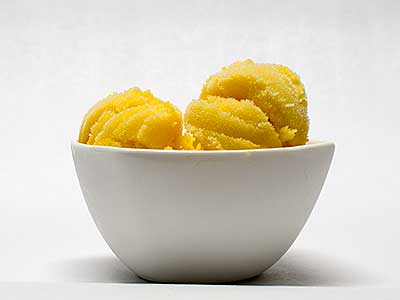May 20, 2013
Intermède

sorbet à la mangue
(mango sorbet)
I hate kitchen gadgets. I like kitchen tools. What’s the difference? Tools are useful and gadgets aren’t. This is my opinion. Most sensible people disagree.
Most dictionaries define gadget in a neutral to positive sense. “A small mechanical device or tool, esp. an ingenious or novel one.” I prefer the less than positive, tertiary definition from the Oxford English Dictionary of “an accessory or adjunct; a knick-knack or gewgaw.” No gewgaws allowed in my kitchen.
I wasn’t always this negative towards gadgets, but after 10 years of working in a kitchen store, how can I be blamed? I was there to teach cooking classes, but there was often some new gadget that the store manager wanted featured in the class, even if it didn’t apply to what was being taught. Some made some sense, but most were just the latest scheme to open the customer’s wallet.
Most gadgets were modern variants of well-established tools. Why do I need a whisk that will stand up in a saucepan? Why do I need collapsing, rubber colanders sold as a set of three when they still take as much space as three stacking, rigid colanders? Why do I need a set of three, stainless steel pans for breading cutlets when three plates work better and come in many sizes? Why do I need a three-in-one peeler that can’t be cleaned when a traditional peeler works just fine and costs substantially less? Not only do most gadgets not work as advertised, but they come in a myriad of colors.
For years, whenever I was teaching a knife-skills class, there was one particular gadget that I was supposed to demonstrate (and endorse): the OXO Good Grips Mango Splitter. I tried, but it was hard when I could do a better job with a knife. I’m sure the device looked good on paper. In practice, it only works well on certain mangos, and there is substantial waste unless to user picks up a knife to trim the remainder left after the splitter does its thing.
Part of the problem is that the variety of mangos commonly available in my area, at least the ones that the store buyer purchased, have fibrous (hairy?) pits. Rather than being distinct like most fruits, these mango pits are the fruit equivalent to a mossy swamp bottom; one that when you stand in it, you’re not quite sure as to where the bottom is. The pit has a mass of fibers that extend out from the pit into the flesh of the fruit. With a knife, I can feel where the fibers end and cut just past them. The mango splitter will do fine on small pits, but on thick ones, the fiber, and sometimes the surface of the pit, are cut off with the flesh. With a knife I can slice the flesh off of very ripe mangos, with the splitter, I can crush a very ripe mango.
Even though I can whittle fresh mangos like a tropical native, most of the time I but then frozen and chunked. When I’ve comparison shopped, the frozen variety are always less expensive, and unlike fruit like strawberries, when defrosted, they are quite like their fresh form.
About five years ago I started preparing a mango mousse. For this dessert, the mango flesh is pureed in a food processor. When I was processing the frozen mango—why wait for it to defrost?—I noticed that the puree seemed similar to a sorbet, only smoother. I tasted some of it, and it was a mango sorbet!
Tasting some of the mango being processed for the mousse is one thing, but if you want to serve this as part of a meal, a little more work is required unless you want to process it right before you serve it. If processed and then refrozen, it will harden too much. (Remember that ice cream freezers are warmer than food freezers.) So it is necessary to add something to the puree so its freezing point is lowered. Two food additives immediately come to mind: alcohol and sugar. Both will work, but the sweetness of the frozen mango is usually already correct.
The mango sorbet shown in the picture had a generous dose of a homemade plum liquor added during processing. I don’t know how much. It just seemed correct at the time, and after a couple of days in the freezer, the mixture was still quite scoopable. The amount of alcohol required is a function of what temperature your freezer gets down to. Mine is set to -20 °C (-5 °F). If the sorbet is too hard, you’ll need to set it in your refrigerator for a few minutes before serving. If your sorbet is too soft, tell your guests that it is a slush and not a sorbet.
I’ve tried this “sorbet” with other frozen fruits, and most can be made to work. Don’t select fruits that are frozen in syrup. Look for those that are plain when frozen. These usually come in plastic bags. Some benefit from the addition of a little heavy cream. The cream improves the texture for both scooping and mouthfeel.
© 2013 Peter Hertzmann. All rights reserved.
